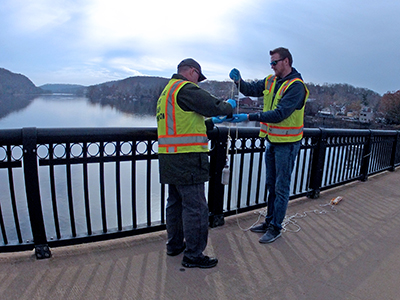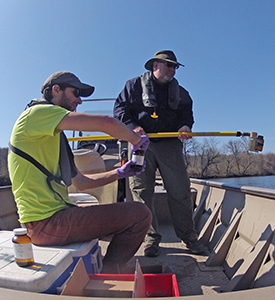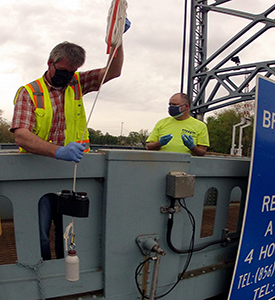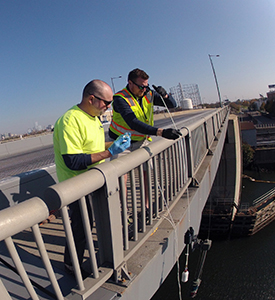Delaware • New Jersey • Pennsylvania
New York • United States of America
- Aquatic Life Designated Use Project
- Bacteria Monitoring
- Biomonitoring Program
- Chlorides Monitoring
- Contaminants of Emerging Concern
- Delaware Estuary Water Quality Monitoring Program
- Dissolved Oxygen and Nutrients
- Modeling
- Other Monitoring (e.g., Toxicity, Fish Tissue, Metals)
- PCBs and PMPs
- Special Protection Waters (SPW)
- Water Resource Data Sets
 |
| DRBC staff collects a Delaware River sample to monitor for 1,4-Dioxane. Photo by DRBC. |
1,4-Dioxane is a synthetic industrial chemical used as a solvent in products such as adhesives, resins, oils and waxes and wood pulping.
Other uses include: a stabilizer for chlorinated organic solvents; in the manufacture of pharmaceuticals, certain plastics and rubber; and it appears as a byproduct of surfactants used in personal care products, detergents and cosmetics.
It is released into the environment from wastewater discharges, hazardous waste sites, landfills, unintended spills, leaks, historical disposal practices of solvents and unregulated manufacturing waste streams.
Since scientific studies indicate that 1,4-Dioxane may pose a threat to human health if ingested in sufficient amounts, the chemical is a contaminant of emerging concern for drinking water supplies.
The EPA has issued a health advisory (non-enforceable), but there is currently no federal drinking water standard for 1,4-Dioxane.
Learn More
• 1,4-Dioxane Fact Sheet (U.S. EPA; pdf)
DRBC is part of a working group that includes representatives from the New Jersey Department of Environmental Protection (NJDEP), the Pennsylvania Department of Environmental Protection (PADEP) and water/wastewater utilities.
The working group has been coordinating to conduct enhanced sampling and assessment to identify potential source(s) of the contaminant and recommend a course of action to address potential risks to the environment or public health.
In-stream water quality results for 1,4 Dioxane from monitoring conducted by DRBC under the most recent working group efforts can be found here (xlsx; dated 12/20/21).
- J: Result is less than the Reporting Limit (RL) but greater than or equal to the Method Detection Limit (MDL) and the concentration is an approximate value.
- U: Indicates the analyte was analyzed for but not detected.
For additional information from the NJDEP on 1,4-Dioxane in the Delaware River: https://www.nj.gov/dep/14-dioxane/
DRBC has engaged its Toxics Advisory Committee, and, in addition to the above-mentioned monitoring efforts, will continue monitoring for 1,4-Dioxane via its Delaware Estuary Water Quality Monitoring and Special Tributary Monitoring programs.
In 2023, samples that were collected in the Delaware River Estuary were all non-detect.
 |
 |
 |
| DRBC staff collects a surface water sample to monitor for 1,4-Dioxane. Photo by DRBC. |
DRBC staff collects a surface water sample to monitor for 1,4-Dioxane. Photo by DRBC. |
DRBC staff collects a surface water sample to monitor for 1,4-Dioxane. Photo by DRBC. |
- 1,4-Dioxane in the Delaware River (pdf 1.6 MB; presentation given at the DRBC TAC Meeting, January 2021)
- ATSDR: 1,4-Dioxane (pdf)
- CDC's National Institute for Occupational Safety and Health (NIOSH): 1,4-Dioxane
- New Jersey DEP: 1,4 Dioxane
- New York: 1,4-Dioxane Limits For Household Cleansing, Personal Care & Cosmetic Products
- Philadelphia Water Department: 1,4-Dioxane (pdf)
- USEPA: 1,4-Dioxane Fact Sheet (pdf)
Copyright © Delaware River Basin Commission,
P.O. Box 7360, West Trenton, NJ 08628-0360
Phone (609)883-9500; Fax (609)883-9522
Thanks to NJ for hosting the DRBC website